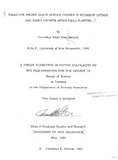| dc.description.abstract | A study was conducted to determine the genetic variation in
black spruce (Picea mariana [Mill.]B.S.P) with respect to nutrient
uptake and use efficiencyon a typical forest soil in central New
Brunswick.
The experimental stock originated from ten plus trees that had
been selected in 1986 for the establishment of seed orchards.
Seedling populations were raised from each plus-tree giving rise to
ten half-sib families. From each of these populations ten plants were
selected for vegetative reproduction by rooting shoot tips. In this way
98 clonal populations were obtained and field tested in a randomized
block design. The plants were remeasured after completion of the
first growing season. Since there was significant variation among
families and clones at the time of planting, comparisons were made on
the basis of annual growth increments and relative growth rates.
Both families and clones varied significantly with respect to
height and diameter growth, and gains in component and total plant
weights. In all cases, clones contributed more to the total
experimental variance than families.
Biomass accretion was closely correlated with N and P uptake
(r=0.911 and 0.892, respectively), suggesting that either one or both
of the elements were limiting growth factors. Clones superior in
growth and nutrient uptake had lower than average shoot:root ratios
and, thus, higher than average root biomass. This would have
provided the plants of these clones with an enlarged surface for
nutrient absorption. Clones superior in growth also ranked highest in
N and or P use efficiency, i.e., the amount of biomass produced per
unit of element taken up.
Fast-growing plants had accumulated the highest quantities of
Al, but the bulk of it was retained in the roots. Aluminum uptake was
further correlated with P uptake, suggesting that both elements
moved towards the roots as a complex ion.
KeyWords: Aluminum, genetic variation, clones, half-sib families,
nutrient uptake, nutrient use efficiency, Picea mariana
[Mill.]B.S.P. | en |

